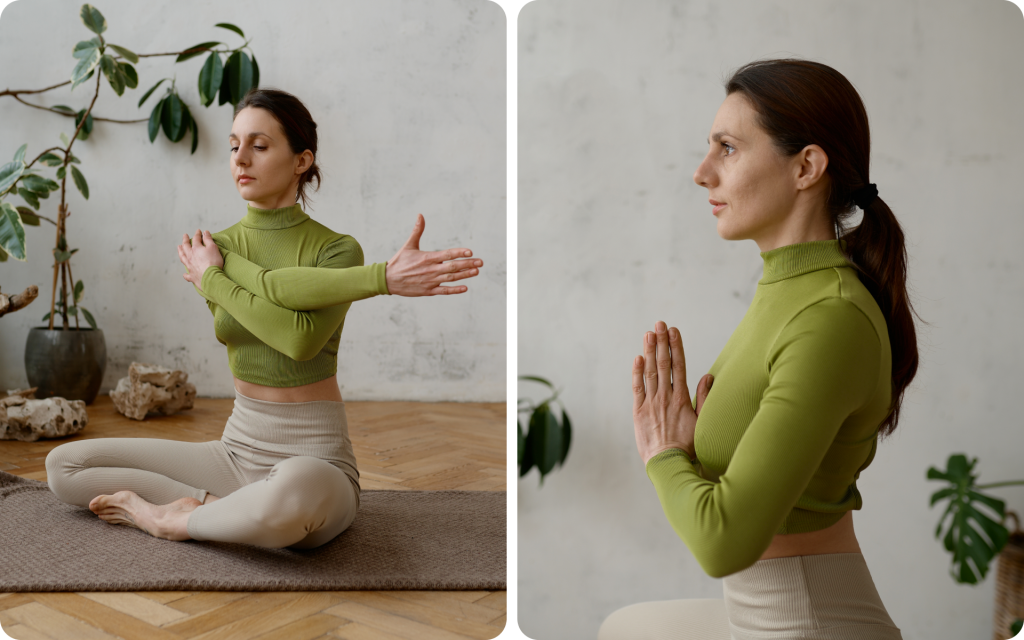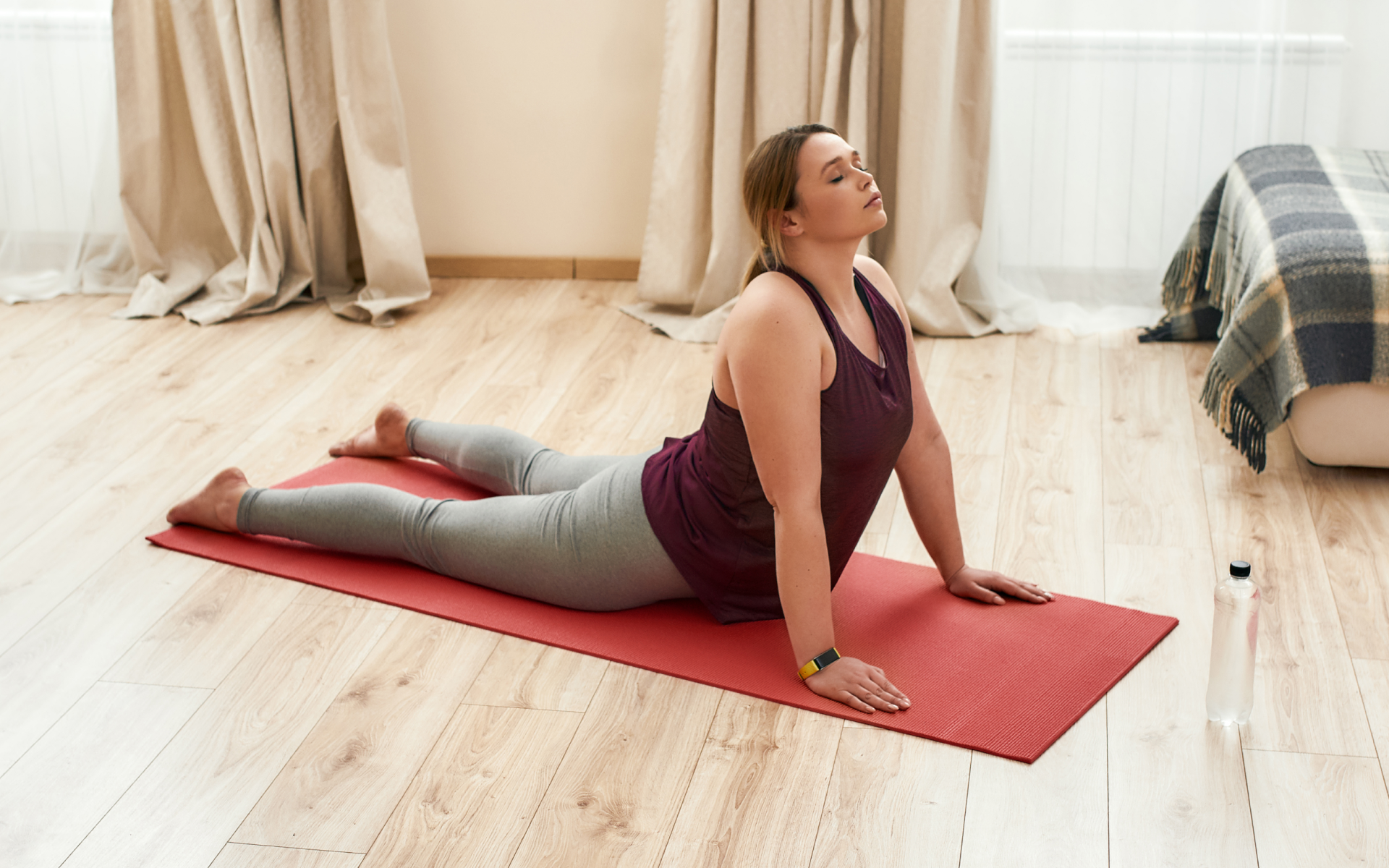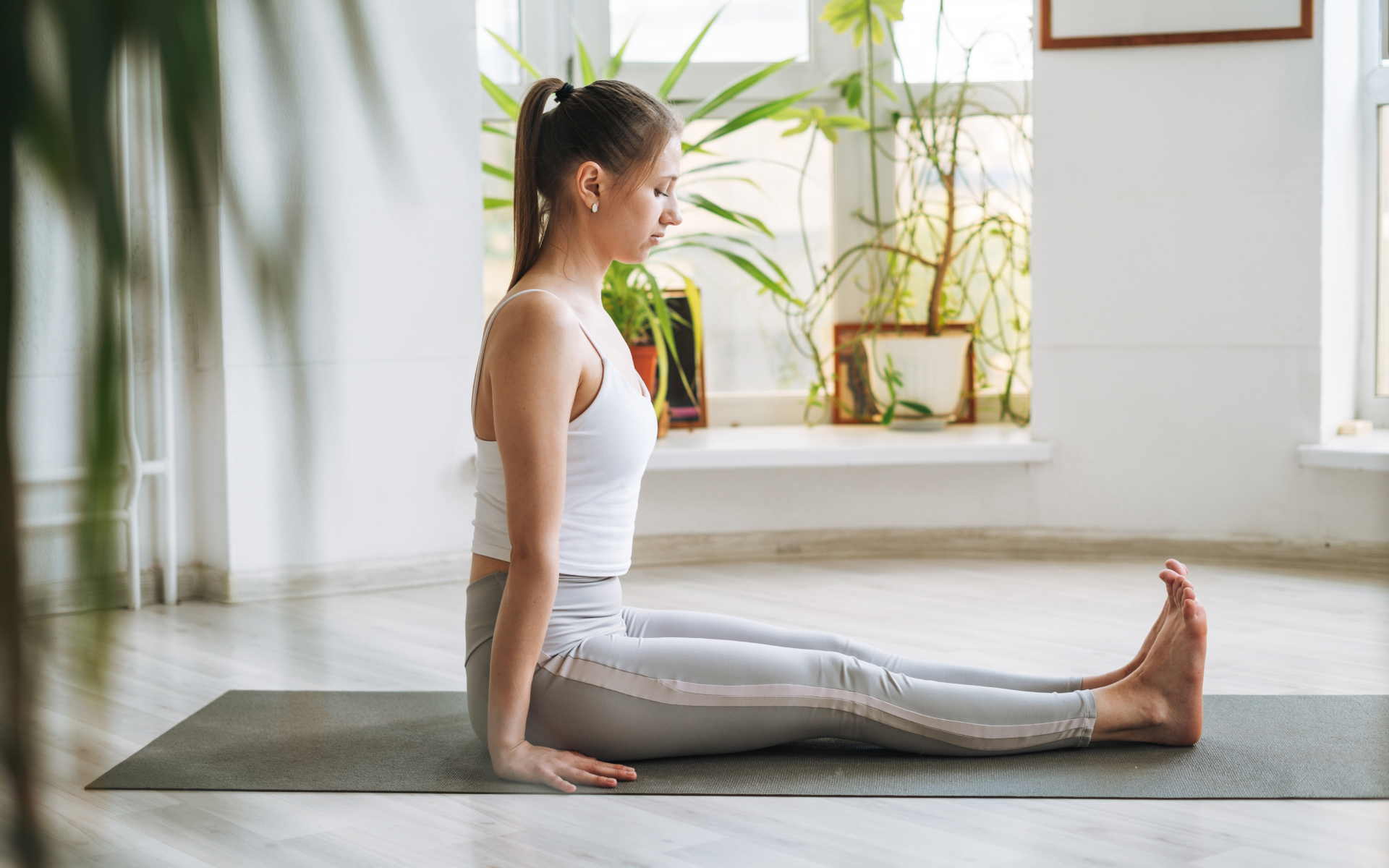Somatic yoga combines traditional yoga postures with principles from somatic movement education, creating a practice that emphasizes internal awareness and nervous system retraining (1).
The body’s response to somatic yoga differs significantly from traditional exercise forms.
Rather than pushing through discomfort or pursuing external goals, practitioners learn to move with conscious attention to internal sensations. The shift in approach triggers specific neurological and physiological changes that can influence everything from muscle tension to stress hormone levels.
Here’s what to know about somatic yoga and its impact on your body.
Is Somatic Yoga Really A Thing?
Somatic yoga isn’t a standardized practice with universally agreed-upon techniques.
Different instructors may emphasize various aspects of somatic education, from pandiculation (a specific muscle release technique) to Feldenkrais-inspired movement explorations (2).
Think of somatic yoga as a fusion of 2 well-established practices.
The term “somatic” refers to the body as perceived from within, making any movement practice that emphasizes internal awareness technically somatic in nature (3).
Traditional yoga stems from the Eastern philosophy, already incorporating many somatic principles.
The focus on breath, body awareness, and mindful movement aligns closely with somatic education methods. What we now call “somatic yoga” simply makes these connections more explicit and incorporates specific techniques from clinical somatics (4).
The central nervous system maintains a baseline level of muscle tension (5) that can become elevated due to stress, injury, or repetitive movement patterns (6). Traditional approaches like stretching and massage provide temporary relief but don’t address the underlying neural programming that maintains these patterns.
Somatic movement techniques work by providing new sensory input to the nervous system, helping to reset these baseline tension levels. The slow, conscious movements allow the brain to develop new neural pathways and abandon dysfunctional patterns that it may have learned over years or decades (7).
This neuroplasticity-based approach explains why somatic yoga can sometimes provide lasting benefits where other interventions have failed. By addressing the root cause of dysfunction at the nervous system level (8), practitioners may experience improvements that extend well beyond the practice session itself.
The integration of breath awareness, mindful movement, and internal attention creates an ideal environment for this type of neural retraining. Regular practice can help individuals develop greater sensitivity to their body’s signals and learn to modulate their nervous system responses more effectively (9).
Read more: Somatic Yoga Moves Explained: Benefits, Examples, and How to Begin
What Are The Benefits Of Somatic Yoga?
The potential benefits of somatic yoga emerge from its unique approach to movement and nervous system training. Research in neuroscience and movement science suggests several areas where this practice may offer advantages over traditional exercise methods.
- Enhanced Proprioception and Body Awareness
Somatic yoga techniques emphasize slow, mindful movement that can significantly improve proprioception, which is your body’s ability to sense its position in space (4).
This heightened awareness allows practitioners to identify areas of tension, asymmetry, or dysfunction that might otherwise go unnoticed.
The practice of moving slowly with eyes closed, a common element in somatic yoga, forces the brain to rely more heavily on internal sensory feedback. This focus on the internal can strengthen the neural pathways responsible for body awareness and may improve coordination and balance over time (10, 11).
- Reduced Chronic Muscle Tension
One of the most significant potential benefits involves the release of chronic muscle tension through somatic movement techniques. Traditional stretching often provides only temporary relief because it doesn’t address the underlying nervous system patterns that maintain muscle tightness (12).
Somatic yoga incorporates pandiculation, a movement technique that involves slowly contracting and then releasing muscles while paying careful attention to the sensations.
This process can reset the nervous system’s baseline muscle tension levels, potentially providing longer-lasting relief than passive stretching (13, 14).
BetterMe will shake off your mental funk, rid you of your energy-zapping habits, and help you sculpt the body of your dreams. Intrigued? Hurry up and change your life for the better!
- Improved Movement Quality and Efficiency
By retraining dysfunctional movement patterns, somatic yoga may help practitioners develop more efficient and graceful movement in daily activities. The emphasis on quality over quantity encourages the development of refined motor control rather than mere strength or flexibility (15).
This focus on movement quality can be particularly beneficial for athletes or individuals recovering from injuries, as it addresses the root causes of compensatory movement patterns rather than just symptoms.
- Enhanced Stress Resilience
The practice offers an easy yoga sequence with meditative aspects, emphasizing nervous system regulation and improved stress resilience.
The practice encourages activation of the parasympathetic nervous system, which promotes relaxation and recovery (16).
Regular practice may help individuals develop better awareness of their stress responses and learn to modulate their nervous system activation more effectively.
Does Somatic Yoga Reduce Cortisol?
The relationship between somatic yoga and cortisol levels represents an area where we must carefully distinguish between theoretical benefits and established scientific evidence. While no specific studies have examined cortisol responses to somatic yoga per se, we can draw insights from research on related practices.
Cortisol serves essential functions in the body, including regulating inflammation, blood sugar, and the sleep-wake cycle (17). The hormone only becomes problematic when levels remain chronically elevated due to ongoing stress or dysfunction in the hypothalamic-pituitary-adrenal (HPA) axis (18).
Studies on traditional yoga practices have shown mixed results regarding stress reduction (19). Research indicates that regular yoga practice can help reduce waking and evening cortisol (20). The slow, mindful movement aspect of somatic yoga may provide similar benefits by activating the parasympathetic nervous system.
The key mechanism likely involves the practice’s emphasis on present-moment awareness, deep breathing, and gentle movement.
These elements can help interrupt the stress response cycle and promote relaxation (21). However, the magnitude and duration of any cortisol-lowering effects would depend on numerous factors, including practice frequency, individual baseline stress levels, and overall lifestyle factors.
It’s worth noting that some degree of cortisol elevation is normal and healthy, particularly in response to exercise or challenging situations. The goal isn’t to eliminate cortisol but to promote healthy patterns of release and recovery (22). Somatic exercises to reduce cortisol could be any yoga poses that make you feel calmer, such as the child’s pose. Our previous post goes into great detail about the yoga sequence for beginners.
Does Somatic Yoga Really Release Trauma?
While trauma-informed yoga practices have gained recognition in therapeutic settings, the specific mechanisms and effectiveness of somatic approaches remain areas of ongoing research.
Trauma can manifest in the body through chronic muscle tension, disturbed sleep, and dysregulated nervous system responses (23). The theory behind somatic approaches suggests that by addressing these physical manifestations, practitioners may be able to process and integrate traumatic experiences more effectively (24).
Some research supports the idea that body-based interventions can complement traditional trauma therapy. A study published in the International Journal of Stress Management found that trauma-sensitive yoga reduced PTSD symptoms in women who hadn’t responded well to traditional talk therapy alone (25).
The slow, gentle movements and emphasis on internal awareness in somatic yoga may help individuals develop a more positive relationship with their bodies and increase their tolerance for internal sensations, both critical aspects of trauma recovery.
However, it’s crucial to understand that trauma release through movement practices is not a predictable or straightforward process.
Trauma therapy requires guidance by qualified mental health professionals, and somatic movement practices should complement rather than replace evidence-based trauma treatments.
The nervous system’s response to trauma is complex and highly individual. While somatic yoga may provide valuable tools for regulation and body awareness, claims about definitively “releasing” trauma through movement alone should be approached with healthy skepticism.
What Does A Somatic Release Feel Like?
The experience of somatic release can vary significantly among individuals, but many report some familiar sensations and experiences.
Many people describe initial sensations of warmth, tingling, or gentle vibrations in areas where tension is being released. These sensations often accompany the gradual lengthening and softening of previously tight muscles. The experience is typically gentle and pleasant, quite different from the sometimes intense sensations of deep stretching or massage.
Some practitioners report feeling a sense of “melting” or “unwinding” as chronic tension patterns begin to shift. The sensation can involve deeper, more relaxed breathing as the nervous system shifts into a more parasympathetic state.
Emotional responses can also occur during somatic release.
Some individuals experience feelings of relief, sadness, or even joy as they release long-held patterns of tension. Experts generally consider these emotional releases to be natural parts of the process, though they can sometimes be surprising or intense.
The timeframe for experiencing somatic release yoga varies considerably.
Some people notice immediate changes in tension levels and movement quality, while others may require weeks or months of consistent practice before experiencing significant shifts.
It’s important to note that not everyone will experience dramatic release sensations.
Some individuals may notice subtle improvements in sleep quality, stress levels, or movement ease without experiencing the more obvious physical sensations described above.
Read more: The Power of Somatic Exercises for Promoting Calmness: A Comprehensive Guide
Can I Lose Weight With Somatic Yoga?
From a pure calorie-burning perspective, somatic yoga’s slow, gentle movements are unlikely to create the significant energy deficit typically required for weight loss.
The metabolic demands of somatic yoga practices are generally low compared to more vigorous forms of exercise.
The emphasis on slow, controlled movements with frequent rest periods means that practitioners burn relatively few calories during sessions. For individuals whose primary goal is weight loss through increased energy expenditure, traditional cardiovascular exercise or strength training would be more effective approaches (26).
However, somatic yoga for weight loss can work through several indirect mechanisms.
The practice’s emphasis on nervous system regulation and stress reduction could help normalize cortisol patterns, which may influence appetite regulation and fat storage patterns, particularly around the midsection (27).
Improved sleep quality, which some practitioners report after beginning somatic yoga practice, can also support healthy weight management. Sleep deprivation disrupts hormones that regulate hunger and satiety, potentially leading to increased appetite and cravings for high-calorie foods (28).
The enhanced body awareness developed through somatic practice may help individuals create a more intuitive relationship with food and hunger cues. This improved interoceptive awareness could support more mindful eating patterns and better recognition of true hunger versus emotional eating triggers (29).
Additionally, by reducing chronic pain and improving movement quality, somatic yoga might enable individuals to engage more comfortably in other forms of physical activity that support weight loss efforts.
How Many Calories Do You Burn In Somatic Yoga?
Quantifying the caloric expenditure of somatic yoga presents challenges due to the practice’s variable nature and the lack of specific research on energy costs. However, we can make reasonable estimates based on the characteristics of the movements and available data on similar activities.
The slow, gentle movements typical of somatic yoga likely burn calories at a rate similar to gentle hatha yoga or basic stretching routines. Research suggests that these types of activities burn approximately 4-6 calories per minute for an average-sized adult (30). However, this can vary based on body weight, muscle mass, and individual metabolic factors.
For a 70-kg (154lb) person, a typical 60-minute somatic yoga session would translate to roughly 220 calories burned, which is significantly less than more vigorous forms of exercise. To put this in perspective, the same individual might burn about 600 calories during a swimming class (31).
The low caloric expenditure reflects the practice’s primary goals, which focus on nervous system retraining and movement quality rather than cardiovascular fitness or strength building. The frequent pauses for internal awareness and the emphasis on moving only within comfortable ranges of motion further reduce the metabolic demands.
Some forms of somatic yoga may incorporate more dynamic movements or more extended sequences, which could increase caloric expenditure.
However, these still fall on the lower end of the exercise intensity spectrum.
For individuals interested in combining somatic principles with higher caloric expenditure, integrating somatic awareness techniques into more vigorous yoga styles or other forms of exercise might provide the best of both worlds.
Intense sweat sessions, working weight loss tips, lip-smacking recipes come in one package with the BetterMe: Health Coaching app—all at your fingertips, start transforming your life now!
How Often Should I Do Somatic Yoga?
The optimal frequency for somatic yoga practice depends on individual goals, current fitness level, and the specific techniques being used. Unlike high-intensity exercise that requires recovery periods, the gentle nature of somatic yoga generally allows for more frequent practice without risk of overtraining.
For individuals new to somatic movement, starting with 2-3 sessions per week allows time to develop the internal awareness skills that are central to the practice. This frequency provides enough consistency to begin retraining movement patterns while allowing time to integrate the neurological changes that occur with each session.
More experienced practitioners often benefit from daily practice, even if sessions are shorter.
The nervous system responds well to consistent, gentle input, and brief 15-20 minute sessions can be efficient for maintaining the benefits of longer practices.
The timing of sessions comes down to individual preference.
Many practitioners find that morning sessions help establish better movement patterns for the day ahead, while evening sessions can help release accumulated tension and prepare the body for sleep.
Bear in mind that somatic yoga is fundamentally about the quality of attention rather than the quantity of movement. A short session practiced with full awareness may be more beneficial than a more extended session done without proper focus.
The best somatic exercise program will be a sustainable practice schedule that allows for consistent engagement with the techniques while respecting individual limitations and life circumstances.
Dynamic yoga styles like Power Yoga, Ashtanga, and Vinyasa flow typically burn the most calories and fat due to their continuous movement and higher intensity (32). Yes, Tai Chi embodies many somatic principles through its emphasis on slow, mindful movement, internal awareness, and mind-body integration. The practice’s focus on feeling sensations from within the body while moving makes it fundamentally somatic in nature (33). While stretching alone cannot definitively release trauma, body-based practices combined with appropriate therapeutic support may help trauma survivors reconnect with their bodies and process stored tension. Professional guidance is essential for trauma-informed movement practices (34). The somatic diet emphasizes mindful eating practices that increase awareness of hunger, satiety, and food sensations. This approach focuses on internal cues rather than external rules, promoting a more intuitive relationship with food and eating behaviors (35).Frequently Asked Questions
Which yoga burns more fat?
Is Tai Chi a somatic practice?
Can stretching release trauma?
What is the somatic diet?
The Bottom Line
For individuals seeking a movement practice that addresses both physical and neurological aspects of wellness, somatic yoga offers a unique approach grounded in scientific understanding of how the nervous system influences movement and health.
While it may not provide the dramatic calorie burn of high-intensity exercise, its potential benefits for nervous system regulation, movement quality, and overall well-being make it a valuable addition to a comprehensive wellness program.
DISCLAIMER:
This article is intended for general informational purposes only and does not serve to address individual circumstances. It is not a substitute for professional advice or help and should not be relied on for making any kind of decision-making. Any action taken as a direct or indirect result of the information in this article is entirely at your own risk and is your sole responsibility.
BetterMe, its content staff, and its medical advisors accept no responsibility for inaccuracies, errors, misstatements, inconsistencies, or omissions and specifically disclaim any liability, loss or risk, personal, professional or otherwise, which may be incurred as a consequence, directly or indirectly, of the use and/or application of any content.
You should always seek the advice of your physician or other qualified health provider with any questions you may have regarding a medical condition or your specific situation. Never disregard professional medical advice or delay seeking it because of BetterMe content. If you suspect or think you may have a medical emergency, call your doctor.
SOURCES:
- What Is Somatic Yoga? (2025, health.clevelandclinic.org)
- The History of Somatics – How Hanna Somatics was developed (2016, somaticmovementcenter.com)
- What is Somatic Movement? (2016, somaticmovementcenter.com)
- Somatic Yoga: Definition, Core Principles, and Techniques (2024, yogabasics.com)
- Nervous System Control of Muscle Tension – Anatomy & Physiology (n.d., open.oregonstate.education)
- Response of Muscle and Tendon to Injury and Overuse – Work-Related Musculoskeletal Disorders (2019, ncbi.nlm.nih.gov)
- How To Retrain Your Brain’s Pain Processing System (2016, somaticmovementcenter.com)
- The Definition of “Somatic,” The History of Somatic Education, and Principles of Clinical Somatic Education (2019, somaticmovementcenter.com)
- Moving With Pain: What Principles From Somatic Practices Can Offer to People Living With Chronic Pain (2020, frontiersin.org)
- What are the known effects of yoga on the brain in relation to motor performances, body awareness and pain? A narrative review (2019, sciencedirect.com)
- The Effect of an Eyes-closed Dance-specific Training Program on Dynamic Balance in Elite Pre-professional Ballet Dancers: A Randomized Controlled Pilot Study (2014, journals.sagepub.com)
- Unlocking Your Body: Your Personal Process of Releasing Tension and Pain (2019, somaticmovementcenter.com)
- Pandiculation: The Safe Alternative to Stretching for Improved Flexibility and Reduced Pain (2024, essentialsomatics.com)
- Pandiculation: nature’s way of maintaining the functional integrity of the myofascial system? (2011, pubmed.ncbi.nlm.nih.gov)
- Motor Cortex Mastery in Somatic Practices (2025, numberanalytics.com)
- Effect of Somatic Experiencing Resiliency-Based Trauma Treatment Training on Quality of Life and Psychological Health as Potential Markers of Resilience in Treating Professionals (2018, frontiersin.org)
- Physiology, Cortisol (2023, ncbi.nlm.nih.gov)
- The Role of Cortisol in Chronic Stress, Neurodegenerative Diseases, and Psychological Disorders (2023, pmc.ncbi.nlm.nih.gov)
- Yoga as an Alternative and Complementary Approach for Stress Management: A Systematic Review (2013, journals.sagepub.com)
- Yoga, mindfulness-based stress reduction and stress-related physiological measures: A meta-analysis (2017, pubmed.ncbi.nlm.nih.gov)
- What Is Somatic Yoga and Its Benefits? (2025, health.clevelandclinic.org)
- Positive upshots of cortisol in everyday life (2016, pmc.ncbi.nlm.nih.gov)
- Understanding the Impact of Trauma – Trauma-Informed Care in Behavioral Health Services (2024, ncbi.nlm.nih.gov)
- Somatic experiencing – effectiveness and key factors of a body-oriented trauma therapy: a scoping literature review (2021, pmc.ncbi.nlm.nih.gov)
- Trauma Sensitive Yoga as a Complementary Treatment for Posttraumatic Stress Disorder: A Qualitative Descriptive Analysis (2016, researchgate.net)
- Role of Physical Activity for Weight Loss and Weight Maintenance (2017, pmc.ncbi.nlm.nih.gov)
- Cortisol: What It Is, Function, Symptoms & Levels (2025, my.clevelandclinic.org)
- Sleep Deprivation and Central Appetite Regulation (2022, pmc.ncbi.nlm.nih.gov)
- A qualitative exploration of perceived barriers and facilitators to following an intuitive eating style (2023, sciencedirect.com)
- Calories burned in 30 minutes of leisure and routine activities (2021, health.harvard.edu)
- Calories Burned Calculator (n.d., omnicalculator.com)
- Yoga Styles Popular in Mumbai: Effectiveness for Weight Loss (2024, researchgate.net)
- The Somatic Work of Thomas Hanna, Tai Chi, and Kinesiology (2020, researchgate.net)
- Healing Through Movement: How Yoga and Stretching Release Trauma and Emotions (2025, alleviant.com)
- Mindful Eating: The Art of Presence While You Eat (2017, diabetesjournals.org)















